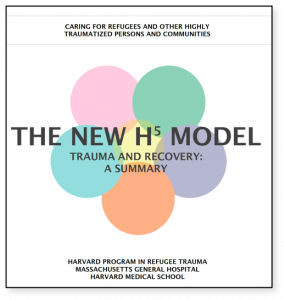Assess Dashboard

Refugee populations present a unique challenge when it comes to developing tools geared toward assessing their overall mental health and well-being. Given the severity of the trauma many of these individuals have been through, cookie cutter mental health assessments can be limited in capturing the depth and complexity of the refugee experience. If there are gaps left by traditional assessment tools, this can lead to ineffective treatment. Considering the magnitude of current global refugee crises such as Ukraine, Afghanistan, Syria, and the Rohingya, NGOs and MHWs need tools that take a wholistic approach to the specific culture and context.
 A recent publication by the Harvard Program in Refugee Trauma provides a nuanced view of refugee trauma and recovery that has largely guided L2T’s assessment approaches. The H5 Model examines five overlapping dimensions that can be barriers to in helping refugees share their Trauma Story. The diagram on the right identifies these five dimensions: Human Rights, Humiliation, Healing, Health Promotion, and Habitat/Housing. By capturing a broad range of the refugee experience, the H5Model seeks to close the socio-cultural gaps in a context so that programs are more effective.
A recent publication by the Harvard Program in Refugee Trauma provides a nuanced view of refugee trauma and recovery that has largely guided L2T’s assessment approaches. The H5 Model examines five overlapping dimensions that can be barriers to in helping refugees share their Trauma Story. The diagram on the right identifies these five dimensions: Human Rights, Humiliation, Healing, Health Promotion, and Habitat/Housing. By capturing a broad range of the refugee experience, the H5Model seeks to close the socio-cultural gaps in a context so that programs are more effective.
The Healing dimension is of particular interest in assessing a context. While humans possess the remarkable ability to self-heal in response to psychological trauma, offering a program designed to engage with and change a person’s behavior represents a significant adaptive challenge. After experiencing trauma, a person often feels helpless and has intense feelings of shame and stigma. A trauma recovery program poses the risk that it will exacerbate those feelings, so persons choose to avoid them.
The concept of “losing face” in many cultures is such a powerful, underlying force in shaping behavior that it must be given serious attention in every context where new behavior is being promoted.
However, trauma recovery proceeds at different rates depending on the individual and the extent of the trauma. In the case of a refugee, by using the barometer of their own sense of well-being, the refugee can decide if the treatment is in line with the level of trauma and self-healing ability for themselves.
At the core of The H5 Model, developed by Dr. Richard Mollica, other key indicator of where someone is in the healing process is their ability to tell their trauma story. Whereas refugees early in the healing process may be hesitant to share their story, those who are further along often are more open to sharing, which, in turn, “can lead to the reduction or elimination of emotional memories that have outlived their adaptive value.” By keeping the trauma story as the focus of a refugee’s recovery, L2T believes its design approach will assist a refugee to become more in touch with their feelings and able to articulate their feelings and gain insight into their mental well-being. Providing the most effective interventions is the central task of L2T Program’s Design & Build tools.
Please Register to view the Assess Dashboard (etc). Once registered you will be able to go directly to the Dashboard via the Menu at the top of the page.